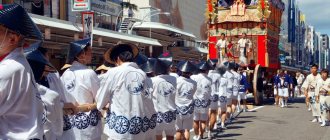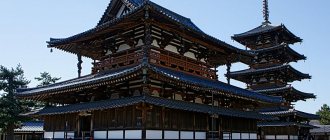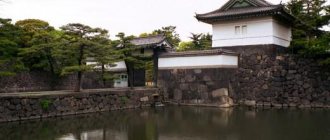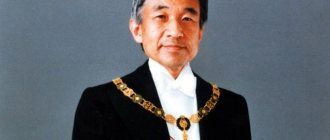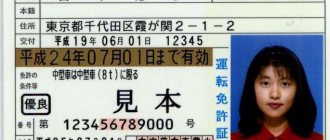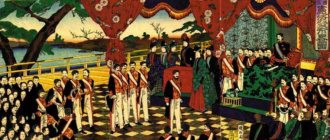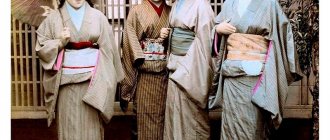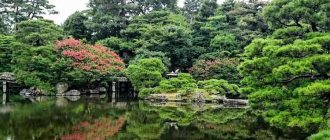30.04.2019
In no other country in the world is there such a reverent attitude towards the person of the emperor in society as in Japan. And this despite the fact that it is the 21st century, and the Land of the Rising Sun is one of the most developed countries in the world. It's all about the mentality of the Japanese, who take care of their history and honor ancient traditions. This is confirmed by the national holiday - State Foundation Day, celebrated annually on February 11. On this day, the first emperor of Japan, Jimmu, was born, who ascended the throne in the 7th century BC.
The place of the emperor in the history of the Japanese metropolis
When assessing imperial power in Japan, it is worth paying attention to the religious component. According to ancient legends, the first supreme ruler to occupy the imperial throne was a descendant of the gods. It was believed that only a person of divine origin could occupy such a high position and only he had the power to unite a disparate country under a single authority. The emperor's divine nature was a very convenient tool for manipulating society. Any attack on the authority of the emperor and criticism of his actions were regarded as blasphemy.
The strengthening of imperial power in Japan was also facilitated by the country's isolated geographical location. The population of the Japanese islands, protected by the sea from external enemies, managed to preserve intact their long-standing traditions, culture, religion and history. For a thousand years, the post of Emperor of Japan and the metropolis itself were preserved. According to some sources, the age of the Japanese ruling dynasty is 2600 years. In this regard, the Imperial House of Japan is the oldest reigning dynasty in the world, and the empire can lay claim to the title of the most ancient state.
By comparison, the surviving monarchical dynasties of Europe are just over a thousand years old.
The origins of the oldest monarchy in the world go back to the 7th-6th centuries BC. The first emperor of Japan is considered to be Jimmu, who was tasked by the gods to subjugate the population of the Japanese islands to his will. The first emperor of Japan, like the subsequent eight emperors who were on the imperial throne of the Land of the Rising Sun at different periods, is credited with a semi-legendary origin.
The first real person with whom the Japanese associate the founding of the Imperial House on the Japanese Islands is considered Emperor Sujin. The reign of Emperor Sujin was 97-29. BC. In official documents that have survived to this day, he is mentioned as the creator of the first Japanese centralized state of Yamato, which became the center of the metropolis for the next 2000 years. The tenth on the list, and in fact the first real emperor of Japan, Sujin, like his predecessors, dates back to the Yayoi era. It should be noted that, unlike Europe, where the periods of reign of a particular dynasty are associated with the duration of the family, on the Japanese Islands the period of reign of a particular dynasty personified an entire era. The name of the era corresponded to the motto under which representatives of one dynastic line ruled.
Upon his accession to the throne, the emperor was called “Tenno Heika” - His Majesty the Emperor; his lifetime name was not officially used. Subsequently, the title of emperor acquired new names that came from China and had a religious connotation. Only after the death of the reigning person was a posthumous name added to the title of emperor. This was done in order to emphasize the divinity of the monarch’s origin.
Despite the fact that the Japanese Imperial House is credited with the title of the oldest ruling dynasty, the title of Emperor acquired official status only in the 6th - 7th centuries. It came to Japan from China. This initiative is attributed to the monks who developed the legal mechanism of sovereignty for central Japan. The main emphasis was on the inextricable connection between the emperor's secular life and his divine nature. The person who ascended the throne simultaneously became not only a person endowed with the highest secular power, but also became a high priest. This mechanism made it possible to achieve complete legitimacy of imperial power in the country.
From this moment the symbols and regalia of imperial power originate:
- sword (symbolizing courage);
- necklace made of precious stones (jasper is a symbol of wealth and prosperity);
- mirror (representing wisdom and maturity).
These symbols managed to survive throughout the history of the reign of the Imperial House of Japan and have survived to this day. They were presented to the crowned person during the succession ceremony and passed from one emperor to another.
Posthumous names of emperors
Tenno, like all members of their family, did not have surnames, and their lifelong names are strictly prohibited and cannot be voiced in the media in Japanese. At the time of the emperor's death, he was given a posthumous name, which was to some extent reflect the main achievements during his reign.
The system of assigning a "temple" name in Japan began to operate in the 7th century and was also adopted in China. Initially, emperors were given too long posthumous names in Japanese, but later it was decided to write them in Chinese and in a shorter version. As a result of this, all emperors who had died previously were retroactively renamed.
During the Meiji period, a decision was made in which posthumous names for emperors began to be selected based on the motto established during his reign.
The eras of the reign of Japanese emperors
The era of Yayoi and all the emperors who occupied the reigning throne during this period can safely be called legendary. Imperial power gained a real and significant place in the history of Japan only in the 5th and 6th centuries, with the advent of the Yamato era (400-539). At this time, the process of forming the first centralized state on the Japanese islands around the Yamato region was taking place. From that moment on, Buddhism was actively spreading in the country, and external relations were being established with Korea and China.
The Yamato era in historical sources is mainly associated with the reign of two emperors: Yuryaku (reigned 456 - 479) and Keitai, who reigned no less - from 507 to 531. Both monarchs are credited with strengthening imperial power in the country and growing the influence of the religious teachings of the East: Taoism, Confucianism and Buddhism. All the emperors of the Yamato era adopted Buddhism, and Taoist ceremonies began to be actively introduced into the Imperial House.
During the Yamato era, the principle of succession to the throne was finally formed. The imperial title will be inherited by the eldest son of the reigning person. Only the male-line descendants of the emperor have the right to the throne, but women often became regents under minor rulers. In Japan, unlike other states, the title of regent was practically correlated with the title of emperor, therefore in the history of the Japanese state there are cases when a woman held the imperial title. The official chronicle of the Imperial House "Annals of Japan" mentions:
Asuka era (539-715):
- Empress Suiko;
- Empress Kogyoku - Saimei;
- Empress Jito;
- Empress Genmei.
Nara era (715-781):
- Empress Gensho;
- Empress Koken - Shotoku.
Edo era (1611-1867):
- Empress Meisho, reigned 1629 to 1643;
- Empress Go-Sakuramachi (1762 – 1771).
The first empress was Suiko, who occupied the divine throne for 35 years (593-628), serving as regent for her nephew Shotoku. During her reign, the first empress officially made Buddhism the main religion in the country. Among her achievements was the adoption of the first official laws in the history of Japan - the 17 Articles of Law.
The second woman to ascend the throne is Kogyoku-Saimei. This woman managed to twice hold the highest state title in the country. She first became empress in February 642, and remained on the throne until the summer of 645. The second time this woman bore the title of empress was in 655-661. The presence of representatives of the fairer sex in the imperial palace is an exceptional fact for Japan. The third representative of the fair sex who became an empress is Genmei. Reign 707-715.
Empress Genmei is credited with taking the initiative to create the first official chronicles of the reigning dynasty. Under her patronage, Japanese chronicles, the Annals of Japan, appeared in 720.
The last female person to hold the highest title was Empress Go-Sakuramachi, who ascended the throne in 1762 and reigned for 9 years. The Statute of the Imperial Family, adopted in 1889, put an end to the possibility of women holding the highest title in the Empire of Japan. It was not possible to rule for two terms in a row due to the peculiarities of the regency system of government, but two women, Empress Koken and Kogyoku-Saimei, managed to wear the imperial crown twice.
With the Yamato era, the gradual development of the state in the form in which we perceive Japan today begins on the Japanese islands. The metropolis, over which the authority of the emperor extends, expanded in its borders. Almost all regions and regions of the country at one time or another became the possessions of the Japanese emperors. With Emperor Kimmei (539 -571) the Asuka era begins. During the 6th – 8th centuries, 15 emperors, including three female empresses, were on the throne in the imperial palace.
A distinctive feature of this era is the introduction of mottos under which the emperor ruled the state. The period of reign of each emperor was considered an era, which emphasized the role and importance of the person in his position.
In the 8th-9th centuries, the Nara era began in Japan, which was characterized by the strengthening of state power in the country. Japan has become a full-fledged state entity with its own laws, governing bodies and territorial division. During this period, the Emperor's Birthday became a public national holiday. It should be admitted that this tradition, one of the few, has survived to this day. Despite the short period, during the Nara era the emperor acquired the status of full and sole sovereign. The power and authority of the reigning person spread throughout the entire territory of the metropolis. The permanent location was the imperial palace, which was located in the ancient capital of the Yamato state, the city of Kyoto.
The Heian era (781-1198) is considered the most dramatic period in Japanese history, marked by political and social instability. For a number of reasons, imperial power began to lose its unshakable authority, becoming a convenient instrument of manipulation in the game of large clans and parties. Gradually, regents and advisers representing the most noble families began to govern the country on behalf of the emperor. The emperor turned into a nominal ruler who had only the right of a recommendatory vote. During the Heian era, there were 33 emperors in the imperial palace. The reign of many of them is characterized by frequent palace coups and conspiracies. Due to the difficult internal political situation, the fate of many royals was tragic. The beginning of the decline of the Imperial House was the formation of the shogunate - an alternative government, which included noble nobles and samurai. Attempts by supporters of strong imperial power to regain lost positions in power by armed means ended in severe defeat.
The emperor's orders and decrees were of a representative nature and concerned mainly state rituals and palace ceremonies. The imperial treasury was practically empty, and the imperial court itself existed through the sale of titles, titles of nobility and government positions.
A similar picture was observed in the Kamakura era (1198-1339). The first attempt to regain lost positions in government was made by Emperor Go-Daigo. His reforms were aimed at restoring the Nara era model of government. With the defeat of the shogunate, an acute military-political crisis began in the country, ending with the division of the Imperial House into two dynasties - Northern and Southern. For the next three hundred years, imperial power in the country was in decline. The period of rule by representatives of the Northern branch of the imperial house gave way to the Muromachi era, during which the crisis of supreme power in the country only intensified. The ensuing Edo era ultimately brought the Imperial House out of oblivion. In the 19th century, imperial power became one of the fundamental symbols of the state. Transformations in the public administration system contribute to the transformation of Japan into an Empire.
The desire for unification
In the 16th century, Japan was united through the efforts of Toyotomi Hideyoshi. Hedonism is developing among the common people; pleasures are placed above all else in life. Painting, astronomy, medicine, sea navigation, and publishing are further developed thanks to openness to European influence. European clothing comes into fashion.
Edo era. Japanese print
Tokugawa Ieyasu becomes the fourth and final shogun. The time of his reign was called the Edo period. Society is stratified into:
- samurai,
- merchants,
- artisans,
- peasants,
- pariah - “unclean”.
Neo-Confucianism comes to the fore as a religion. In general, the life of the population during this period is stable.
Japanese emperors in modern times
The first royal person under whom Japan received the status of an Empire is the 122nd Emperor Meiji. During his reign from 1867 to 1912, Japan under his leadership achieved tremendous success. The country emerged from foreign political and economic isolation, beginning to actively instill Western values locally and in society. This rise was facilitated not only by the personality of Emperor Meiji himself, who ruled under the motto of enlightened rule, but also by radical reforms of public administration, the banking sector and the economy. In 1889, Japan received the first Constitution in its history, which became one of the very first in the Asia-Pacific region.
In accordance with the text of the Constitution, the emperor was the head of the Supreme Power in the empire, had immunity and was equated to a deity. The Emperor's responsibilities included control over all government bodies. The orders of the royal person had the force of laws that had to be approved by the country's Parliament. The goals and objectives that the Japanese emperors set for themselves over the Meiji period become the basis of the state's foreign policy, which are enshrined at the level of legislative acts.
The Emperor had the right to convene and dissolve parliament, was the Supreme Commander-in-Chief of the Armed Forces of the Empire and the first person in the executive branch of the country. From now on, the emperors had the right to bestow titles and titles and make decisions on appointments to government positions. The emperor could, by his decision, declare war, introduce martial law, and enter into military and political alliances on his own behalf.
The period of the reign of Emperor Meiji became an important era in the development of the Japanese state, receiving the same name - the Meiji era. In the 20th century, after the death of Emperor Meiji, the place in the residence was occupied by 2 people, with whose reign the most striking and tragic moments in the history of Japan are associated:
- 123rd Emperor of Japan Taisho, who bore the lifelong name Yoshihito and occupied the throne in 1912-1926 (the era of reign - great justice);
- The 124th Emperor of Japan, Showa, reigned for almost 72 years, from 1926 to 1989. Lifetime name Hirohito (era and motto of reign - enlightened peace).
Under Emperor Hirohito, the Empire of Japan participated in World War II on the side of Nazi Germany. Japan's participation in the world conflict as an aggressor led the country to a crushing defeat and brought Japan to the brink of disaster. As a result of the defeat, for the first time the question of the Emperor's voluntary abdication of power arose. This was one of the conditions imposed by the Allies for Japan's surrender in the war. However, as a result of lengthy negotiations, the emperor managed to retain supreme power in the country. The new, post-war Constitution of 1947 made him officially the nominal head of state, depriving him of divine status.
From that moment on, the country established a full-fledged constitutional monarchy, similar to the one that operates in the United Kingdom of Great Britain, the Kingdom of Sweden and the Netherlands. From now on, the emperor does not participate in any way in the management of state affairs. All powers in domestic and foreign policy were transferred to the Cabinet of Ministers, which is headed by the Prime Minister. The monarch is assigned representative functions and a leading role in state ceremonies.
The emperor retained the right to submit to the Japanese parliament the candidacy of the prime minister and the head of the Supreme Court. As a legislative initiative, the monarch can submit amendments to the current legislation to parliament for consideration. The Emperor of Japan has the right:
- proclaim elections of deputies of Parliament;
- approve the appointment of ministers and civil servants;
- grant amnesty;
- accept credentials from ambassadors of foreign states.
The disposal of the property of the Imperial House is carried out only with the approval of the Cabinet of Ministers, and the maintenance of the court is approved at the level of the country's budget. According to the new Constitution, the monarch lost the functions of the Head of the Armed Forces of the country, which were transferred to the introduction of the Prime Minister.
Emperor Hirohito held his title the longest in the history of the country. In 1989, after his death, the imperial throne was taken by his eldest son Akihito, who at that time was 53 years old. The inauguration or coronation of the 125th Emperor of Japan took place on November 12, 1990.
Today Emperor Akihito is already 84 years old. The head of the Imperial House has a wife, Empress Michiko, and three children. The main heir is the emperor's eldest son, Crown Prince Naruhito. According to a new law passed by the Japanese Diet in 2021, the current reigning emperor has the right to voluntarily abdicate the throne in favor of his eldest son.
Brief overview of the history of imperial power
The country underwent many unexpected changes in the ruling circles - first the state was led by emperors, then regents, which later replaced the totalitarian regime of the shogunate, and then the power of monarchs resumed. Fate was not always kind to the Japanese emperors. One of the turning points was also 1945, the period after the defeat of Japan in World War II.
Thus, in the same year, Shinto ceased to be the state religion. In 1946, the reigning Emperor Hirohito renounced his divine origins. In 1947, the new Constitution of Japan was adopted, according to which the emperor was declared a symbol of the state and the unity of the nation; now he can participate in various ceremonies (present various awards, receive ambassadors), but must coordinate all his actions with the Cabinet of Ministers. Also, the monarch is deprived of all functions of governing the state and has no right to interfere with the leadership of the country by the prime minister. In addition, imperial property can be inherited only with the consent of Parliament.
Also in 1947, a new law was signed, according to which the monarch remains the ruler until the end of his days. The heir is chosen from among his male relatives.
In total, the history of Japan includes 125 emperors.
Residence of the Emperors of Japan
The current reigning Emperor of Japan, together with his royal family, lives in the Koiko palace complex, which is located in the very center of the Japanese capital. Despite its location, the imperial palace is a real fortress, as it was built on the site of the medieval Edo Castle. Koiko Palace became the residence of the Emperor of Japan in 1869, from the moment Emperor Meji moved his court from Kyoto to Tokyo.
The palace was seriously damaged during the Second World War and was restored only in 1968. The new palace complex is the largest active residence of a head of state in the world. According to a long-standing tradition, the emperor’s reception chambers are also located here, where the head of state holds official meetings and ceremonies. On the emperor's birthdays and major public holidays, part of the palace complex is open to tourists.
If you have any questions, leave them in the comments below the article. We or our visitors will be happy to answer them
